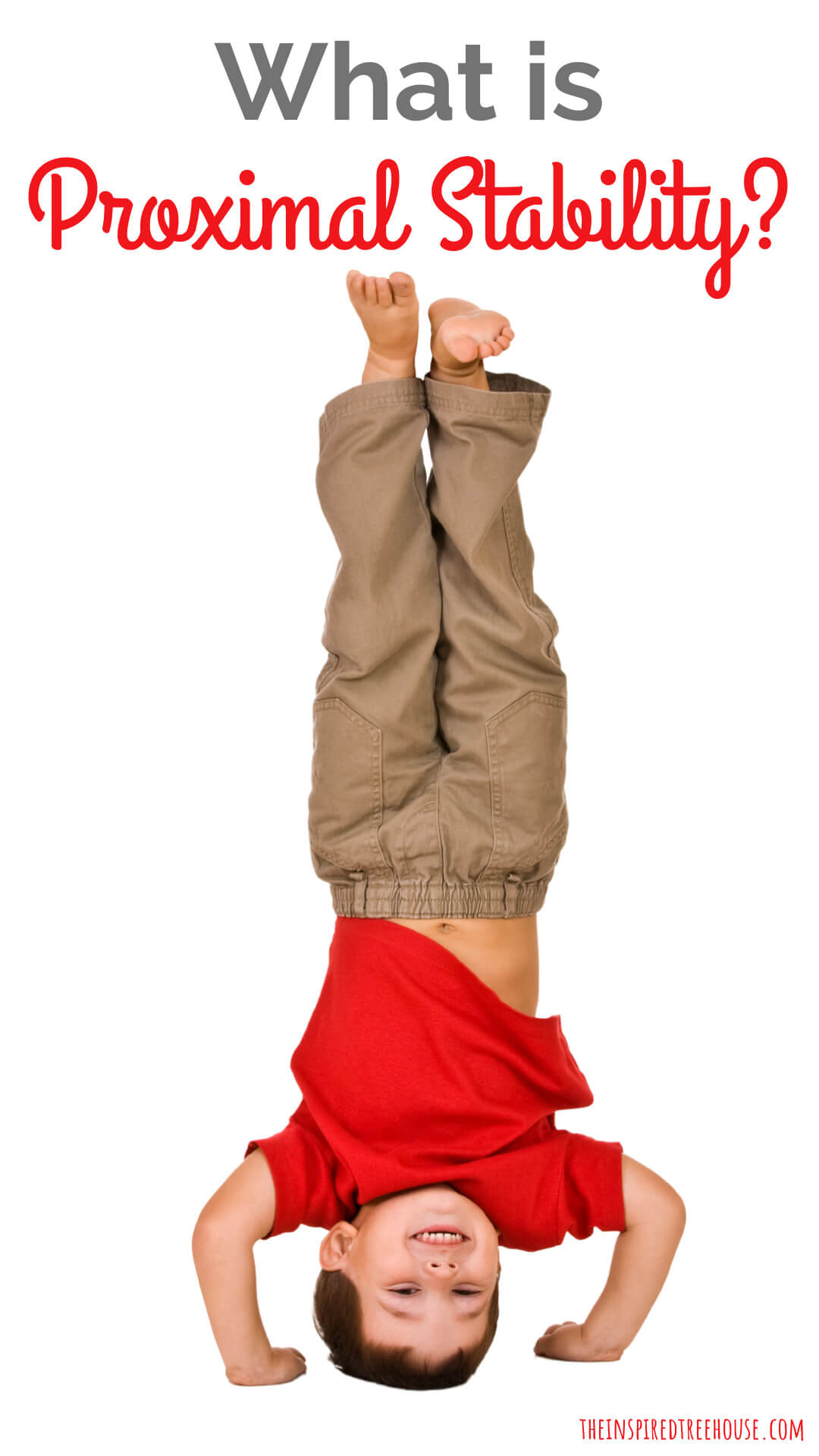There is a saying in the therapy world:
Proximal stability before distal mobility
What Does Proximal Stability Mean?
Think of it like a chain. When a child uses the tiny muscles of his hand to pick up a Cheerio from the table and bring it to his mouth, he must have a stable chain of muscles running from his core muscles to his shoulder to his elbow, to his wrist. If that chain of muscles, beginning at his core, isn’t stable and strong, it will be very difficult for him to get that tiny piece of cereal to its target.
So when we focus on proximal strength and stability (stability in the muscles closest to the center of the body), we are helping to support free movement in the parts of the body further away from the center (distal body parts).
Core Strength
The core is the center of your body, the anchor, the most proximal (or nearest to your center). This is why we have so many posts and resources about core strength, tummy time, and playing in quadruped. These types of activities strengthen the core and encourage weight bearing through the knees, elbows, hips and shoulders providing the opportunity for proprioceptive input, strengthening, and – ultimately – stability.
From the core, you move outward (remember, proximal to distal). Strong core, then strong hips and shoulders, then strong elbows and knees and, finally, strong hands and feet. Of course, it’s not the “elbow” or “knee” that is strong, it’s the muscles around the joints supporting them.
Functional Outcomes of Proximal Stability
Recently, we had a reader (an Occupational Therapist) write in to tell us that the mother of one of her patients was questioning why she was spending so much time on core strengthening in her therapy sessions and not focusing time on the specific goals that were written on an IEP. The goals on the IEP were specific to handwriting and scissor skills.
Knowing about proximal and distal stability and how they work together to improve functional skills is a crucial part of what we do as therapists. Core strength would be one of the first things we would look at if a child was having difficulty with fine motor skills. It would be one of our go-to interventions for improving handwriting or scissor skills. And it would likely be a beneficial therapeutic intervention for the child because it would most likely improve their overall gross motor, fine motor and sensory motor skills.
So…how can you work on this whole proximal stability this and really help your child rock those fine motor skills?

Proximal Stability Activities
Because we know that proximal and distal stability are inherently linked to one another, there are ways we can work on building proximal stability to positively impact distal mobility…therefore building function!
1 || Vertical Surfaces
Working on vertical surfaces is a great way to work on proximal stability of the upper extremities. Those shoulders are working hard as the child writes or draws on an easel, a window, or a pad of paper on the wall.
2 || Tall Kneel
Try doing fine motor activities in a tall kneel position. This way of sitting gives great proprioceptive input through the knees and hips and causes activation of the core to stay centered.
3 ||Shortening the Chain
Try eliminating pieces of the body chain to focus on one at a time. For example, have the child use an incline board on a table top surface when writing. The incline gives support at the wrist and into the forearm which gives the shoulder and core the big job of maintaining stability.
4 || Weightbearing
Weightbearing through the hands provides a major strengthening opportunity for a multitude of the muscles of the hand while also waking up the rest of the arm all the way to the shoulder girdle. This can be done by having your child lie on her tummy to color, doing yoga poses like downward dog, or wheelbarrow walking!
Want to learn about some of the other fundamental concepts that we use in our pediatric therapy practice? Check out these posts and freebies…
Bilateral Coordination [FREE Printable]
Tactile Defensiveness [FREE Printable]
Planes of Movement [FREE Printable]


Latest posts by Lauren Drobnjak (see all)
- End of the Year Gifts for Therapists - April 14, 2024
- Playful Therapy Posters to Spruce Up Your Room - March 30, 2024
- How to Help a Baby Crawl & Creative Crawling Patterns We See in Therapy - March 19, 2024


[…] is a great post on proximal stability from my friends at The Inspired Treehouse (pediatric Occupational Therapist and Physical […]